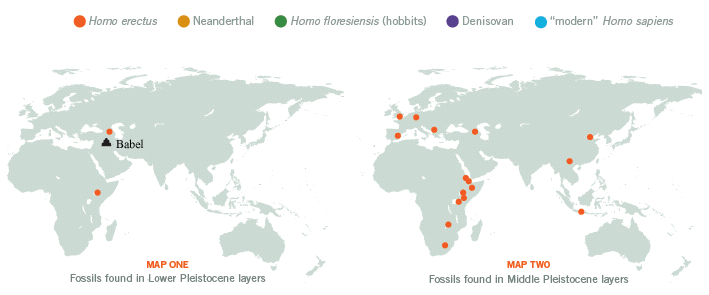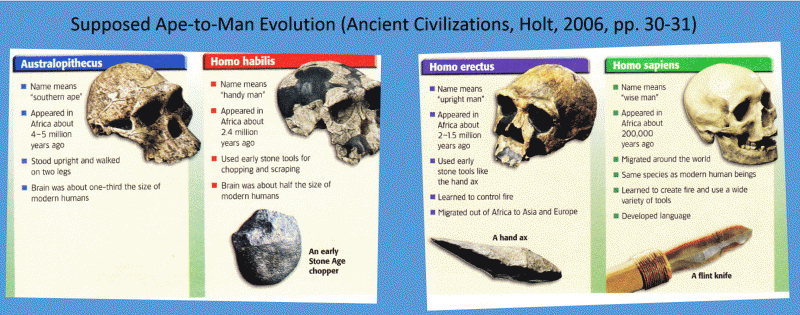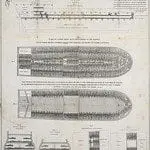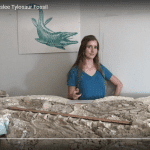The third supposed ‘link’ in the supposed ‘evolutionary chain’ of humanity is Homo erectus, whose name means “upright man” because his skeleton allowed him to freely walk upright like people today.

In most textbooks, Homo erectus is placed between the ape-like Homo habilis (which more-likely belongs in the Australopithecus [ape] category) and our own species, Homo sapiens.1 Unlike his supposed ape-like ancestors, however, “From the neck down Homo erectus looks more like Homo sapiens than Australopithecus.”2 However, they also say that, “though its body design closely resembled ours, its mind is still a mystery.…“If you could look one in the eyes, you wouldn’t want to. It might appear to be human, but you wouldn’t connect. You’d be prey.””3
The reasons some evolutionists give for portraying Homo erectus as ‘pre-human’ have to do with his so-called ‘primitive’ skull shape,4 small brain size (and supposedly limited intellect), and presumed lack of speech and imagination.2 As Christians, we must take these claims seriously, as Scripture says that man has always had the ability to speak (Gen. 2:23) and the intellect and imagination to complete complex tasks like building cities (Gen. 4:17), creating musical instruments (Gen. 4:21), and forging iron (Gen. 4:22). So, who was ‘Upright Man’ really?
First, let’s look at his skull. The 6th grade textbook History Alive! The Ancient World states that, “The face of Upright Man looked more like a modern human than those of earlier hominids did.…But they still had a large ridge above the eyes, a thicker skull, and a jaw that stuck out.”1 However, many of the skull features seen in Homo erectus are also found among human populations today, so they should be regarded as variation within the human family and not ‘primitive’ features.5 You have probably seen people with these same characteristics!
So, what about his brain size? It’s important to recognize that brain size and intelligence are not directly related, so a small brain doesn’t necessarily mean a lack of intelligence. Although smaller than average, the Homo erectus brain still falls within the range of variability for modern humans, so it can’t be used as evidence against his full humanity.6
Sharply contrasting with the typical, less-than-human picture of Homo erectus is the evidence we find of what he did. “According to evidence of charcoal at Zhoukoudian [a H. erectus site in China] and elsewhere, he now learns to control fire and cook food. And he makes far better stone tools and weapons [than Homo habilis, which supposedly made ‘primitive tools’], great quantities of large, double-edged, teardrop-shaped “hand axes” (at least we call them that, although no one knows just how they were used.)”4

This presents a big challenge to the idea that H. erectus was too primitive to speak, as, “Hand axes were the Swiss army knives of their day, and passing on the technology to make them, some scientists argue, required more than physical gestures,” indicating that H. erectus had the ability to pass on information verbally.7
What initially led researchers away from the idea of a talking H. erectus was their belief that the spinal cord opening in one vertebra from the specimen known as ‘Turkana Boy,’ was too small for the nerves controlling rib muscles used in exhaling, and thereby would have constricted speech.7 However, scientists have found that the openings in other Homo erectus vertebrae fall within the range of modern humans, indicating that, “Although it’s impossible to confirm that our prehistoric ancestors talked, Meyer notes, H. erectus at Dmanisi [a site in East Asia] faced no respiratory limitations on speech.” Some now suspect that Turkana Boy’s spine opening suffered from stunted growth and doesn’t represent the norm for Homo erectus.8
Perhaps the greatest testimony to the full humanity of “Upright Man” is the fact that we find his remains at sites spanning the old world, from Africa to East Asia, China, and the Indonesian island of Java. The latter of these indicates that he likely had at least some knowledge of seafaring.9 Evolutionist researchers explain the exploration of Homo erectus this way, “The early ape-men [Australopithecus and Homo habilis] probably did not venture far afield. But erectus, with his enlarged, more complicated brain, inevitably developed intellectual curiosity. Like humans today, he must have wanted to see what was on the other side of the mountain.”4
Although Homo erectus culture wasn’t nearly as technologically advanced as ours, technological sophistication shouldn’t be equated with being ‘more-evolved.’ Even today, in the era of smartphones, bulletproof vests, and genetically modified foods, some cultures could still be considered ‘hunter-gatherer’ societies.9 Are these people more ‘primitive’ or ‘less-evolved’? Definitely not.
Instead, geographic isolation, an inability to reach other cultures, and limited knowledge (not a limited intellect) and resources force them to make the best use of what they have to survive. And Homo erectus certainly did a good job with what he had! According to the History Alive textbook, “Upright man was around longer than any other hominid group, from 1.8 million to 200,000 B.C.E.”1 Not bad for a supposed “ape-man”!
Starting with a biblical worldview, we know that humans were made separate from the animals, “in the image of God” (Genesis 1:26-27) with the unique ability to speak, imagine (Gen. 2:20), create, and explore (Gen. 4:16) from the start. Genesis 9:19 tells us that all humans alive today descended from Noah’s three sons who were survived the Flood aboard the Ark. We learn in Genesis 11 that the early descendants of Noah’s three sons gathered together in the Middle East to build the city and Tower of Babel, but were forced to scatter to all parts of the earth when God confused their languages.

From this big picture, the Homo erectus people were fully-human descendants of Adam and Noah who left Babel and migrated to different parts of the world, first to east Asia and Africa, then later to China and Indonesia.11 They likely possessed unique genes and were possibly exposed to environmental conditions that caused them to look different from other early peoples.12,13 When they left Babel, they were probably isolated from other people groups and no longer had access to the advanced technology used to build the city, so they had to develop their own stone-tool technology and survive on what they could hunt, gather, and cook. Sadly, this group later died out (probably within the first few hundred years after Babel), leaving their remains for us to study today.
So, regardless of whatever the current (and constantly changing) evolutionary opinion is, Homo erectus was fully-human, confirming that God indeed, “made from one man every nation of mankind to live on the all the face of the earth, having determined allotted periods and the boundaries of their dwelling place, that they should seek God, and perhaps feel their way toward him and find him.” (Acts 17:26-27)
Free Resources for Further Learning:
Making Sense of ‘Apemen’ Claims
Turkana Boy—Getting Past the Propaganda
References:
1Frey, Wendy, John Bergez, and Amy Joseph. History Alive!: The Ancient World. Palo Alto, CA: Teachers’ Curriculum Institute, 2004. 18. Print.
2Gore, Rick. “The Dawn of Humans: Expanding Worlds.” National Geographic 191.5 (1997): 92. Print.
3Gore, Rick. “The Dawn of Humans: The First Steps.” National Geographic 191.2 (1997): 97. Print.
4Weaver, Kenneth F., “Stones, Bones, and Early Man: The Search for Our Ancestors.” National Geographic 168.5 (1979): 609. Print.
5MacIntosh, N.W.G. and Larnach, S.L., The persistence of Homo erectus traits in Australian aboriginal crania, Archaeology and Physical Anthropology in Oceania 7(1):1–7, 1972.
6Marvin Lubenow, Bones of Contention (Grand Rapids, MI: Baker Books, 1992): 138.
7Ref. 4, p. 94.
8Bower, Bruce. “Evolutionary Back Story: Thoroughly Modern Spine Supported Human Ancestor.” ScienceNews. Society for Science & the Public, 31 Oct. 2015. Web. 3 May 2006. <https://www.sciencenews.org/node/10504>.
9Catchpoole, David. “The People That Forgot Time (and Much Else, Too).” Creation.com. Creation Ministries International, n.d. Web. 6 Nov. 2015. <http://creation.com/the-people-that-forgot-time-and-much-else-too>.
10Menton, David, and John UpChurch. “Who Were Cavemen?” Answers Magazine. Answers in Genesis, 1 Apr. 2012. Web. 03 Nov. 2015. <https://answersingenesis.org/human-evolution/cavemen/who-were-cavemen/>.
11Snelling, Andrew A., and Mike Matthews. “When Did Cavemen Live?” Answers Magazine. Answers in Genesis, 1 Apr. 2012. Web. 03 Nov. 2015. <https://answersingenesis.org/human-evolution/cavemen/when-did-cavemen-live/>.
12Line, Peter. “Explaining Robust Humans.” Journal of Creation 27.3 (2013): 64-71. Creation.com. Creation Ministries International. Web. 3 Nov. 2015. <http://creation.com/explaining-robust-humans>.
13Ref. 6, p. 144-156.







